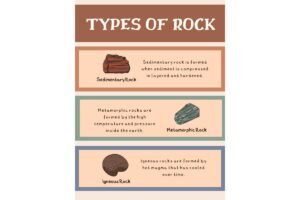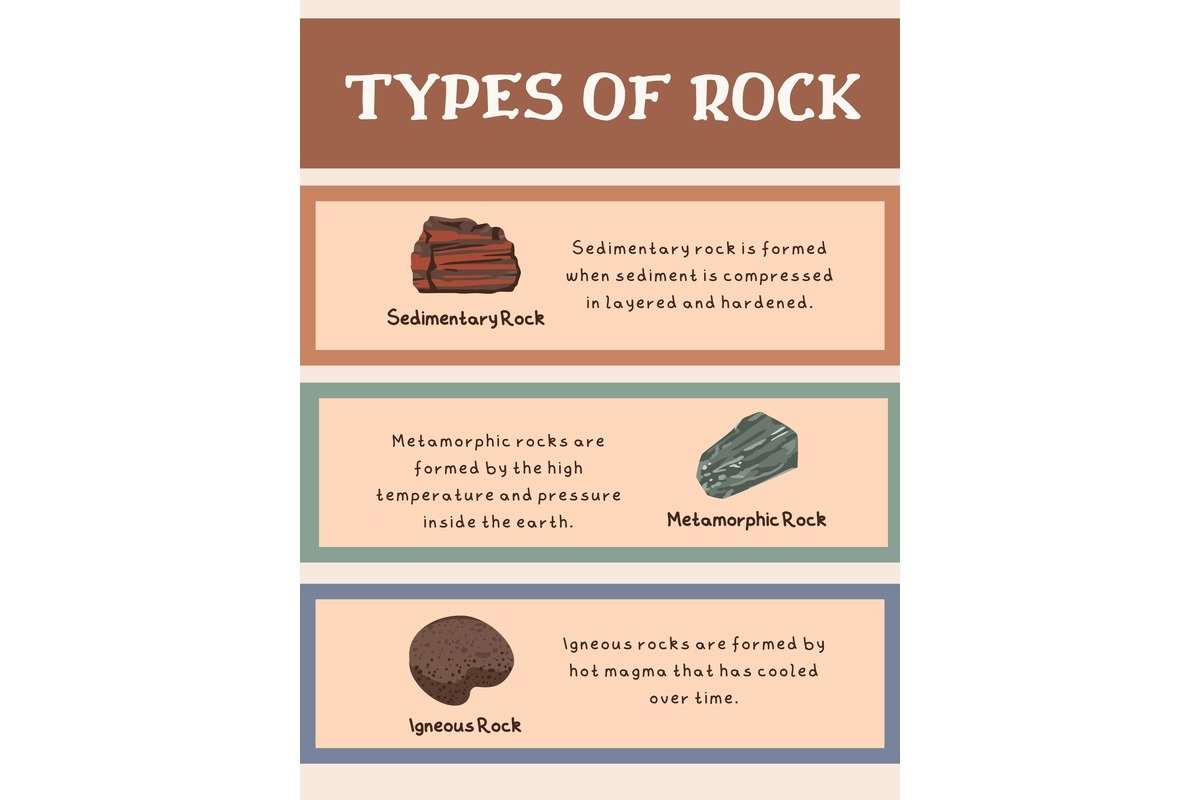Introduction to Rocks
Rocks and different types of rocks are the solid material that forms the Earth’s crust. They are composed of minerals, which are naturally occurring substances with specific chemical compositions and physical properties. Rocks come in various sizes and shapes, ranging from tiny grains of sand to massive mountain formations. Understanding rocks is essential for comprehending the Earth’s geological processes and history.
Definition of Rocks
In geological terms, rocks are aggregates of one or more minerals. They are classified based on their mineral composition, texture, and mode of formation. Rocks can also contain organic materials, such as fossils, which provide valuable clues about past environments and life forms.
Importance of Studying Rocks
Studying rocks is crucial for several reasons:
- Geological Understanding: Rocks offer insights into the Earth’s geological history, including past environmental conditions, climate changes, and tectonic activities.
- Resource Exploration: Many valuable resources, such as minerals, metals, and fossil fuels, are found within rocks. Understanding rock formations helps in identifying potential resource-rich areas for exploration.
- Environmental Assessment: Rocks play a significant role in shaping landscapes and ecosystems. Studying rocks helps in assessing environmental impacts, such as soil erosion, pollution, and habitat destruction.
- Engineering and Construction: Knowledge of rock properties is essential for engineering projects, such as building foundations, road construction, and mining operations. Different types of rocks have varying strengths, durability, and suitability for construction purposes.
Classification of Rocks

Rocks are broadly classified into three main types:
- Igneous Rocks: Formed from the solidification of molten magma or lava.
- Sedimentary Rocks: Formed from the accumulation and compression of sediments.
- Metamorphic Rocks: Formed from the alteration of existing rocks due to heat, pressure, or chemical processes.
Each rock type has distinct characteristics, formation processes, and practical applications.
Igneous Rocks
Igneous rocks form from the cooling and solidification of molten magma or lava. They can be classified into two main types:
- Intrusive Igneous Rocks: Formed beneath the Earth’s surface from slowly cooling magma. Examples include granite and diorite.
- Extrusive Igneous Rocks: Formed on the Earth’s surface from rapidly cooling lava. Examples include basalt and obsidian.
Igneous rocks often exhibit a crystalline texture and can contain minerals such as quartz, feldspar, and mica. They are commonly used in construction, as decorative stones, and in the manufacturing of ceramics and glass.
Sedimentary Rocks
Sedimentary rocks are formed from the accumulation, compaction, and cementation of sediments over time. They can be classified based on their composition and texture:
- Clastic Sedimentary Rocks: Formed from the accumulation of fragmented rock particles, such as sandstone and shale.
- Chemical Sedimentary Rocks: Formed from the precipitation of minerals from water, such as limestone and rock salt.
- Organic Sedimentary Rocks: Formed from the accumulation of organic materials, such as coal and limestone.
Sedimentary rocks often exhibit layering or bedding and can contain fossils. They are valuable in understanding past environments, climate changes, and Earth’s history. Sedimentary rocks are used in construction, as building materials, and in the production of cement and ceramics.
Metamorphic Rocks
Metamorphic rocks are formed from the alteration of existing rocks under high temperature, pressure, or chemically reactive fluids. They can be classified based on their texture and mineral composition:
- Foliated Metamorphic Rocks: Exhibiting a layered or banded texture, such as slate and schist.
- Non-foliated Metamorphic Rocks: Exhibiting a uniform texture without layering, such as marble and quartzite.
Metamorphic rocks often contain minerals that are not found in their parent rocks and exhibit distinctive textures, such as foliation or recrystallization. They are used in construction, as decorative stones, and in sculpture and carving.
Comparison of Rock Types
Each type of rock has unique characteristics:
- Composition: Igneous rocks are primarily composed of minerals formed from magma or lava. Sedimentary rocks contain fragments of pre-existing rocks, organic materials, or precipitated minerals. Metamorphic rocks are derived from the alteration of existing rocks under high temperature and pressure.
- Texture: Igneous rocks can have a crystalline texture with interlocking mineral grains. Sedimentary rocks often exhibit layering or bedding due to the deposition and compaction of sediments. Metamorphic rocks may exhibit foliation or banding due to the reorientation of mineral crystals.
- Formation Conditions: Igneous rocks form from the cooling and solidification of magma or lava. Sedimentary rocks form through the accumulation and compaction of sediments. Metamorphic rocks form from the alteration of existing rocks under high temperature and pressure.
Rock Cycle
The rock cycle describes the continuous process of rock formation, alteration, and transformation on Earth’s surface. It involves various processes, including weathering, erosion, sedimentation, metamorphism, and volcanic activity. The rock cycle plays a crucial role in shaping Earth’s landscapes and geological features over millions of years.
Factors Affecting Rock Formation
Several factors influence the formation of rocks:
- Temperature: High temperatures can cause rocks to melt and form magma, while low temperatures can lead to the crystallization of minerals.
- Pressure: High pressure, such as that found deep within the Earth’s crust, can alter the mineral composition and texture of rocks.
- Weathering: Physical and chemical weathering processes, such as erosion, abrasion, and chemical dissolution, break down rocks into sediments and alter their properties.
Applications of Rocks
Rocks have diverse applications in various fields:
- Construction: Rocks are used as building materials for roads, bridges, buildings, and monuments due to their strength and durability.
- Artifacts: Rocks, such as marble and granite, are used in sculpture, carving, and ornamental objects due to their aesthetic appeal and workability.
- Landscaping: Rocks are used in landscaping projects for retaining walls, pathways, and decorative features to enhance outdoor spaces.
Rock Identification Techniques
Geologists use various techniques to identify rocks:
- Physical Properties: Observing characteristics such as color, texture, hardness, and cleavage can help in identifying rock types.
- Chemical Properties: Analyzing the chemical composition and mineral content of rocks through laboratory tests, such as X-ray diffraction and spectroscopy, provides valuable information for identification.
Significance of Studying Rocks
Studying rocks has significant implications for:
- Geological Studies: Rocks provide clues about Earth’s history, past environments, and geological processes, aiding in geological research and exploration.
- Environmental Impact: Understanding the composition and distribution of rocks helps in assessing environmental impacts, such as soil erosion, contamination, and habitat destruction.
Challenges in Rock Study
Despite advancements in technology, several challenges persist in rock study:
- Identification Difficulties: Some rocks may have complex mineral compositions or textures, making identification challenging for geologists.
- Accessibility to Certain Locations: Remote or inaccessible geological formations pose challenges for fieldwork and sample collection, limiting research opportunities in certain areas.
Future Prospects in Rock Research
The future of rock research holds promise with advancements in technology and exploration methods:
- Technological Advancements: Innovative analytical techniques, such as high-resolution imaging and isotopic dating, enable detailed analysis of rocks at the microscopic and molecular levels.
- Exploration of New Rock Formations: Continued exploration of uncharted regions, such as deep-sea trenches and polar ice caps, may uncover new rock formations and geological phenomena, expanding our understanding of Earth’s geology.
Conclusion
In conclusion, rocks are integral components of the Earth’s crust, shaping landscapes, environments, and geological processes. Understanding the different types of rocks, their characteristics, formation processes, and practical applications is essential for various scientific disciplines and human activities. By studying rocks, we gain valuable insights into Earth’s past, present, and future, contributing to scientific knowledge and societal development.
FAQs
- What are the three main types of rocks?
- Igneous, sedimentary, and metamorphic.
- How are sedimentary rocks formed?
- Sedimentary rocks form from the accumulation and compaction of sediments over time.
- What factors influence rock formation?
- Temperature, pressure, and weathering are key factors affecting rock formation.
- What are some applications of rocks?
- Rocks are used in construction, art, landscaping, and various industrial processes.
- Why is studying rocks important?
- Studying rocks provides insights into Earth’s geological history, resources, and environmental processes.






One thought on “Types of Rocks”